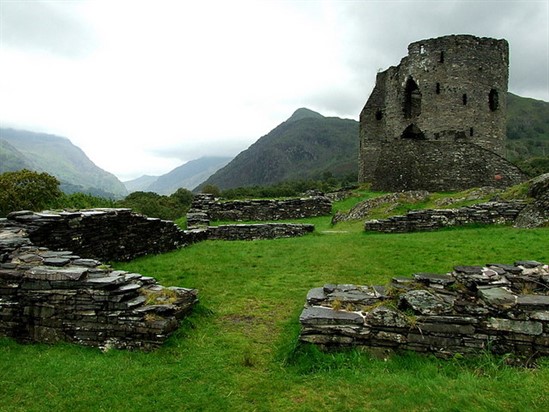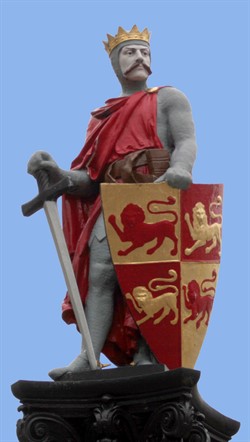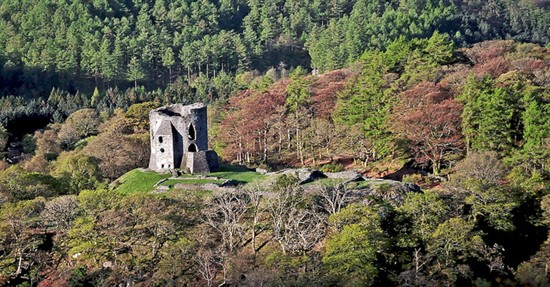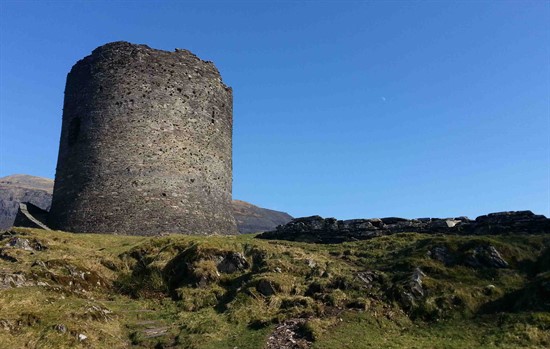Posted on 22/11/2017 by David
Normally it would be impossible to miss a 46ft tall stone tower on an 80ft hill above a lake. Yet Llanberis is so blessed with wrap-around scenery that it's easy to miss Dolbadarn Castle. Standing above Llyn Padarn lake, Dolbadarn comes as a surprise to many visitors.
The castle was built by Welsh princes rather than England's King Edward I as he sought to quell the Welsh rebellion, and was one of the final strongholds of Welsh rule. It was also famously painted by Turner in 1800.
Dolbadarn boasts a fascinating history, well worth contemplating as you explore the tower and the remains of its outer fortifications.

Dolbadarn: Llywelyn the Great's second castle
Dolbadarn is a castle of Welsh princes. It was built in the early 13th century, long before Edward's forces arrived or the castles at Caernarfon, Conwy, Rhuddlan, Flint, Beaumaris and Harlech were built.
It was built by Llywelyn ap Iorwerth (Llywelyn the Great) a prince of Gwynedd who by a canny combination of war and diplomacy dominated Wales for 45 years. He was born in nearby Dolwyddelan (not the castle that's there today but a nearby fortress lost to the mists of time).
who by a canny combination of war and diplomacy dominated Wales for 45 years. He was born in nearby Dolwyddelan (not the castle that's there today but a nearby fortress lost to the mists of time).
Llywelyn's first foray into castle building was Castell y Bere, an innovative stone Welsh castle in the shadow of mighty Cadair Idris in southern Snowdonia in the 1220s.
Shortly afterwards he began the first phases of Dolbadarn Castle, constructing the initial stone fortifications on the site. As well as controlling the important mountain pass, it's possible Llywelyn saw the location as symbolic of his mountain-and-coast kingdom.
Following his death, Llywelyn's grandson Llywelyn ap Gruffudd took power and imprisoned his brother Owain so he could extend his power across Wales. Historians remain undecided as to whether Owain was imprisoned in Dolbadarn or Criccieth.
The Normans are coming!
In 1282 Llywelyn ap Gruffudd died fighting Edward's forces near Builth in Mid Wales. Brother Dafydd ap Gruffydd assumed power but a year later his influence was drastically reduced and his government was based from Dolbadarn Castle.
Edward deployed 7,000 troops to capture and kill Dafydd and Dolbadarn was occupied by Norman forces in October 1283.
Edward began constructing his 'Ring of Iron' castles, replacing the old Welsh administrative system with a new principality governed from Caernarfon.
Dolbadarn was no longer relevant and within two years timber from the castle was being used by the Normans for the construction of Caernarfon's mighty fortress.

More roles for Dolbadarn - including artists' subject
Dolbadarn's story didn't end with Edward I. While the tower was left to ruin the remaining parts of the castle continued to be used as a manor house into the 14th century.
By the 18th century the castle was ruined and uninhabited but from the 1760s onwards it found favour with artists interested in the fashionable landscape styles known as 'Sublime' and 'Picturesque'.
Dolbadarn was a useful subject for paintings where the landscape was deliberately altered or enhanced by the painter for dramatic effect.
J. M. W. Turner's 1800 work 'Dolbadarn Castle' depicts the brooding castle looming over the landscape and became particularly famous during this time.
Dolbadarn - what you'll see today
Even with a large hotel, main road and a number of tourist attractions nearby, Dolbadarn somehow remains a peaceful and evocative spot. Follow the fingerpost tourist signs from the main road and a couple of well constructed paths to the low hill of Dolbadarn.
The keep was modelled on early 13th-century English round towers built along the Welsh borders. The entrance is on the first first floor rather than ground level, similar to other Welsh castles.
The keep had a portcullis which would have been drawn up past the window of the tower's second floor. This floor would have formed the main chamber in the keep and featured a large fireplace and a latrine.
Parapet and battlements have long been destroyed but historians still describe Dolbadarn as "the finest surviving example of a Welsh round tower."
There are lesser remains of a rectangular west tower and a similar tower in the south overlooking the castle's entrance. At the north end of Dolbadarn's rocky outcrop is a 50ft by 27ft hall, stretching across the courtyard.

Looking for other legendary castles? We've previously visited Criccieth in Gwynedd and Rhuddlan in Flintshire and next time we'll be exploring Edward's iconic Anglesey castle at Beaumaris.
Images courtesy of: Dolbadarn Castle at sunrise by Hefin Owen, 2014. Llewelyn Fawr in Conwy by Rhion Pritchard, Dolbadarn guarding the pass by Ian Dalgliesh, 2008.

